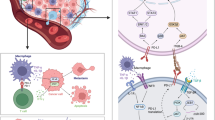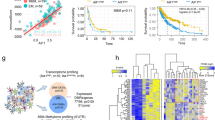Abstract
Tumor-associated macrophages (TAMs) are important regulators of the complex interplay between immune system and breast cancer. TAMs fuel the cancer progression and metastasis by reprogramming their specific functional phenotype in cancer settings. Therefore, it is important to clarify the mechanisms of shaping specific functional phenotype of macrophages in tumor milieu. LncRNA profiles of TAMs were identified by LncRNA microarray. Flow cytometry was used to detect the surface markers of TAMs. The co-localization among lincRNA-p21, p53 and Mouse Double Minute 2 (MDM2) was identified by FISH probe and immunofluorescence. PyVT-MMTV and BALB/c mice were used for in vivo analysis. In the present work, we found that lincRNA-p21 significantly up-regulated in 4T1 educated macrophages. LincRNA-p21 knockdown facilitated macrophage polarization into pro-inflammatory M1 in tumor microenvironment, which might be caused by MDM2 eliciting proteasome-dependent degradation to p53 and activated NF-κB and STAT3 pathway. TAMs with lincRNA-p21 knockdown induced cancer cell apoptosis, inhibited tumor cell migration and invasion. In vivo, lincRNA-p21 knockdown macrophage adoptive transfer could alleviate breast cancer progression. Our results indicated that lincRNA-p21 was a key regulator of TAMs function in tumor milieu. Our data also shed a light on novel therapeutic targets of tumors characterized by monocytes/macrophages infiltration.






Similar content being viewed by others
Abbreviations
- ACK:
-
Red blood cell lysis buffer
- CCK-8:
-
Cell counting kit-8
- CTL:
-
Cytotoxic T lymphocyte
- GO:
-
Gene ontology
- LLC:
-
Lewis lung carcinoma
- lncRNA:
-
Long non-coding RNA
- miRNA:
-
Small RNA
- NK:
-
Natural killer
- ROS:
-
Reactive oxygen species
- siRNA:
-
Small interfering RNA
- SPF:
-
Specific pathogen-free
- TAMs:
-
Tumor-associated macrophages
- 4T1CM:
-
4T1 mouse breast tumor cell supernatant
References
DeSantis C, Ma J, Bryan L (2013) Jemal A (2014) Breast cancer statistics. CA-Cancer J Clin 64(1):52–62. https://doi.org/10.3322/caac.21203
Huneidi SA, Wright NC, Atkinson A, Bhatia S, Singh P (2018) Factors associated with physical inactivity in adult breast cancer survivors-A population-based study. Cancer Med. https://doi.org/10.1002/cam4.1847
Matsumoto A, Jinno H, Ando T, Fujii T, Nakamura T, Saito J, Takahashi M, Hayashida T, Kitagawa Y (2016) Biological markers of invasive breast cancer. Jpn J Clin Oncol 46(2):99–105. https://doi.org/10.1093/jjco/hyv153
King TA, Morrow M (2015) Surgical issues in patients with breast cancer receiving neoadjuvant chemotherapy. Nat Rev Clin Oncol 12(6):335–343. https://doi.org/10.1038/nrclinonc.2015.63
Soysal SD, Tzankov A, Muenst SE (2015) Role of the tumor microenvironment in breast cancer. Pathobiology 82(3–4):142–152. https://doi.org/10.1159/000430499
Bussard KM, Mutkus L, Stumpf K, Gomez-Manzano C, Marini FC (2016) Tumor-associated stromal cells as key contributors to the tumor microenvironment. Br Cancer Res 18(1):84. https://doi.org/10.1186/s13058-016-0740-2
Goswami KK, Ghosh T, Ghosh S, Sarkar M, Bose A, Baral R (2017) Tumor promoting role of anti-tumor macrophages in tumor microenvironment. Cell Immunol 316:1–10. https://doi.org/10.1016/j.cellimm.2017.04.005
Murray PJ (2017) Macrophage polarization. Annu Rev Physiol 79:541–566. https://doi.org/10.1146/annurev-physiol-022516-034339
Liu YC, Zou XB, Chai YF, Yao YM (2014) Macrophage polarization in inflammatory diseases. Int J Biol Sci 10(5):520–529. https://doi.org/10.7150/ijbs.8879
Tariq M, Zhang J, Liang G, Ding L, He Q, Yang B (2017) Macrophage polarization: anti-cancer strategies to target tumor-associated macrophage in breast cancer. J Cell Biochem 118(9):2484–2501. https://doi.org/10.1002/jcb.25895
Mills CD, Lenz LL, Harris RA (2016) A breakthrough: macrophage-directed cancer immunotherapy. Cancer Res 76(3):513–516. https://doi.org/10.1158/0008-5472.can-15-1737
Ngambenjawong C, Gustafson HH, Pun SH (2017) Progress in tumor-associated macrophage (TAM)-targeted therapeutics. Adv Drug Deliv Rev 114:206–221. https://doi.org/10.1016/j.addr.2017.04.010
Dehne N, Mora J, Namgaladze D, Weigert A, Brune B (2017) Cancer cell and macrophage cross-talk in the tumor microenvironment. Curr Opin Pharmacol 35:12–19. https://doi.org/10.1016/j.coph.2017.04.007
Aras S, Zaidi MR (2017) TAMeless traitors: macrophages in cancer progression and metastasis. Br J Cancer 117(11):1583–1591. https://doi.org/10.1038/bjc.2017.356
Mantovani A, Marchesi F, Malesci A, Laghi L, Allavena P (2017) Tumour-associated macrophages as treatment targets in oncology. Nat Rev Clin Oncol 14(7):399–416. https://doi.org/10.1038/nrclinonc.2016.217
Woo SR, Corrales L, Gajewski TF (2015) Innate immune recognition of cancer. Annu Rev Immunol 33:445–474. https://doi.org/10.1146/annurev-immunol-032414-112043
Biswas SK, Mantovani A (2010) Macrophage plasticity and interaction with lymphocyte subsets: cancer as a paradigm. Nat Immunol 11(10):889–896. https://doi.org/10.1038/ni.1937
Schmitt AM, Chang HY (2016) Long noncoding RNAs in cancer pathways. Cancer Cell 29(4):452–463. https://doi.org/10.1016/j.ccell.2016.03.010
Ferre F, Colantoni A, Helmer-Citterich M (2016) Revealing protein-lncRNA interaction. Brief Bioinform 17(1):106–116. https://doi.org/10.1093/bib/bbv031
Marchese FP, Raimondi I, Huarte M (2017) The multidimensional mechanisms of long noncoding RNA function. Genome Biol 18(1):206. https://doi.org/10.1186/s13059-017-1348-2
Chen YG, Satpathy AT, Chang HY (2017) Gene regulation in the immune system by long noncoding RNAs. Nat Immunol 18(9):962–972. https://doi.org/10.1038/ni.3771
Fischer M (2017) Census and evaluation of p53 target genes. Oncogene 36(28):3943–3956. https://doi.org/10.1038/onc.2016.502
Wu G, Cai J, Han Y, Chen J, Huang ZP, Chen C, Cai Y, Huang H, Yang Y, Liu Y, Xu Z, He D, Zhang X, Hu X, Pinello L, Zhong D, He F, Yuan GC, Wang DZ, Zeng C (2014) LincRNA-p21 regulates neointima formation, vascular smooth muscle cell proliferation, apoptosis, and atherosclerosis by enhancing p53 activity. Circulation 130(17):1452–1465. https://doi.org/10.1161/circulationaha.114.011675
Castellano JJ, Navarro A, Vinolas N, Marrades RM, Moises J, Cordeiro A, Saco A, Munoz C, Fuster D, Molins L, Ramirez J, Monzo M (2016) LincRNA-p21 impacts prognosis in resected non-small cell lung cancer patients through angiogenesis regulation. J Thorac Oncol 11(12):2173–2182. https://doi.org/10.1016/j.jtho.2016.07.015
Spurlock CF 3rd, Tossberg JT, Matlock BK, Olsen NJ, Aune TM (2014) Methotrexate inhibits NF-kappaB activity via long intergenic (noncoding) RNA-p21 induction. Arthritis Rheumatol 66(11):2947–2957. https://doi.org/10.1002/art.38805
Shen Y, Liu Y, Sun T, Yang W (2017) LincRNA-p21 knockdown enhances radiosensitivity of hypoxic tumor cells by reducing autophagy through HIF-1/Akt/mTOR/P70S6K pathway. Exp Cell Res 358(2):188–198. https://doi.org/10.1016/j.yexcr.2017.06.016
Na YR, Je S, Seok SH (2018) Metabolic features of macrophages in inflammatory diseases and cancer. Cancer Lett 413:46–58. https://doi.org/10.1016/j.canlet.2017.10.044
Artyomov MN, Sergushichev A, Schilling JD (2016) Integrating immunometabolism and macrophage diversity. Semin Immunol 28(5):417–424. https://doi.org/10.1016/j.smim.2016.10.004
Tan HY, Wang N, Li S, Hong M, Wang X, Feng Y (2016) The reactive oxygen species in macrophage polarization: reflecting its dual role in progression and treatment of human diseases. Oxid Med Cell Longev 2016:2795090. https://doi.org/10.1155/2016/2795090
Wade M, Li YC, Wahl GM (2013) MDM2, MDMX and p53 in oncogenesis and cancer therapy. Nat Rev Cancer 13(2):83–96. https://doi.org/10.1038/nrc3430
Jin X, Yao T, Zhou Z, Zhu J, Zhang S, Hu W, Shen C (2015) Advanced glycation end products enhance macrophages polarization into M1 phenotype through activating RAGE/NF-kappaB pathway. Biomed Res Int 2015:732450. https://doi.org/10.1155/2015/732450
Luo Z, Wang Q, Lau WB, Lau B, Xu L, Zhao L, Yang H, Feng M, Xuan Y, Yang Y, Lei L, Wang C, Yi T, Zhao X, Wei Y, Zhou S (2016) Tumor microenvironment: the culprit for ovarian cancer metastasis? Cancer Lett 377(2):174–182. https://doi.org/10.1016/j.canlet.2016.04.038
Choi J, Gyamfi J, Jang H, Koo JS (2018) The role of tumor-associated macrophage in breast cancer biology. Histol Histopathol 33(2):133–145. https://doi.org/10.14670/HH-11-916
Sica A, Erreni M, Allavena P, Porta C (2015) Macrophage polarization in pathology. Cell Mol Life Sci 72(21):4111–4126. https://doi.org/10.1007/s00018-015-1995-y
Rothlin CV, Carrera-Silva EA, Bosurgi L, Ghosh S (2015) TAM receptor signaling in immune homeostasis. Annu Rev Immunol 33:355–391. https://doi.org/10.1146/annurev-immunol-032414-112103
Qiu SQ, Waaijer SJH, Zwager MC, de Vries EGE, van der Vegt B, Schroder CP (2018) Tumor-associated macrophages in breast cancer: innocent bystander or important player? Cancer Treat Rev 70:178–189. https://doi.org/10.1016/j.ctrv.2018.08.010
Huarte M, Guttman M, Feldser D, Garber M, Koziol MJ, Kenzelmann-Broz D, Khalil AM, Zuk O, Amit I, Rabani M, Attardi LD, Regev A, Lander ES, Jacks T, Rinn JL (2010) A large intergenic noncoding RNA induced by p53 mediates global gene repression in the p53 response. Cell 142(3):409–419. https://doi.org/10.1016/j.cell.2010.06.040
Inoue K, Fry EA, Frazier DP (2016) Transcription factors that interact with p53 and Mdm2. Int J Cancer 138(7):1577–1585. https://doi.org/10.1002/ijc.29663
Tang Z, Chen WY, Shimada M, Nguyen UT, Kim J, Sun XJ, Sengoku T, McGinty RK, Fernandez JP, Muir TW, Roeder RG (2013) SET1 and p300 act synergistically, through coupled histone modifications, in transcriptional activation by p53. Cell 154(2):297–310. https://doi.org/10.1016/j.cell.2013.06.027
Fan Y, Mao R, Yang J (2013) NF-kappaB and STAT3 signaling pathways collaboratively link inflammation to cancer. Protein Cell 4(3):176–185. https://doi.org/10.1007/s13238-013-2084-3
Guo H, Jin D, Chen X (2014) Lipocalin 2 is a regulator of macrophage polarization and NF-kappaB/STAT3 pathway activation. Mol Endocrinol 28(10):1616–1628. https://doi.org/10.1210/me.2014-1092
Li L, Ng DS, Mah WC, Almeida FF, Rahmat SA, Rao VK, Leow SC, Laudisi F, Peh MT, Goh AM, Lim JS, Wright GD, Mortellaro A, Taneja R, Ginhoux F, Lee CG, Moore PK, Lane DP (2015) A unique role for p53 in the regulation of M2 macrophage polarization. Cell Death Differ 22(7):1081–1093. https://doi.org/10.1038/cdd.2014.212
Tang SS, Zheng BY, Xiong XD (2015) LincRNA-p21: Implications in Human Diseases. Int J Mol Sci 16(8):18732–18740. https://doi.org/10.3390/ijms160818732
Acknowledgements
This work was supported by Key University Science Research Project of Jiangsu Province (Grant No. 16KJA320005), the Social Development Foundation of Jiangsu Province (Grant No. BE2016716). The maternal and child project in Jiangsu Province (Grant No. F201511); Changzhou applied basic research project (CJ20180037).
Ethics declarations
Conflict of interest
The authors declare that there is no conflict of interest.
Additional information
Publisher's Note
Springer Nature remains neutral with regard to jurisdictional claims in published maps and institutional affiliations.
Rights and permissions
About this article
Cite this article
Zhou, L., Tian, Y., Guo, F. et al. LincRNA-p21 knockdown reversed tumor-associated macrophages function by promoting MDM2 to antagonize* p53 activation and alleviate breast cancer development. Cancer Immunol Immunother 69, 835–846 (2020). https://doi.org/10.1007/s00262-020-02511-0
Received:
Accepted:
Published:
Issue Date:
DOI: https://doi.org/10.1007/s00262-020-02511-0




